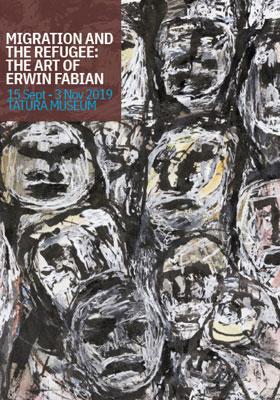Erwin Fabian died in Melbourne on 19 January 2020, aged 104. Erwin, one of Australia's pre-eminent artists, came to Australia on the Dunera, though he rarely said so. The Dunera boy label was not for him.
An exhibition of his work, entitled 'Migration and the Refugee: The Art of Erwin Fabian', was held at the Tatura museum in Victoria from 15 September to 3 November 2019. The exhibition catalogue is reproduced here, alongside images of the artworks displayed. An expanded version of this exhibition was staged at the Matheson Library, Monash University, in 2021.
 Download a copy of Migration and the Refugee: The Art of Erwin Fabian
Download a copy of Migration and the Refugee: The Art of Erwin Fabian
Erwin Fridrich Alfred Fabian was born into a family of artists in Berlin on 5 November 1915. His parents Max and Else had met at an art class — Max the teacher and a well-known painter, Else one of his students. Art filled the home they made for themselves and their children.
From a young age Fabian hoped to be an artist. He painted and drew and took evening classes at the School of Applied Arts in Berlin. In 1937 he left Germany, having been warned that, as a Jew, he was not safe. From 1938 to June 1940 Fabian lived in London, where his artistic skills allowed him to eke out an existence working on the design of book covers and advertising posters. On 28 June 1940, Fabian was arrested and interned, one of thousands of ‘enemy aliens’ in wartime Britain to suffer this fate.
On 10 July, he and more than 2,000 other men, most of them refugees from Hitler’s Reich, and most of them Jewish, were herded aboard the HMT Dunera at Liverpool and deported to Australia, where they were to be interned for the duration of the war.
The Dunera docked in Sydney on 6 September 1940. For the next eight and a half months, Fabian was interned at Hay, in the New South Wales Riverina. In camp 7, he met emerging and established artists of rare talent and creativity. The Bauhaus-trained artist Georg Teltscher lived in the same hut, number 26. Klaus Friedeberger, like Fabian an aspiring artist from Berlin, was in hut 23. Friedeberger and Fabian became close friends, and remain so eighty years later. Both men had sketched pictures on the Dunera, and they continued to make art in the camp, experimenting with styles and techniques. Their teacher was the distinguished artist Hein Heckroth, hut 25.
In May 1941, Fabian was among a group of about 400 internees who were moved to an internment camp in Orange, in the Central Tablelands of New South Wales. After two months there, they were transferred to Tatura in the Goulburn Valley, Victoria. At both Orange and Tatura, Fabian continued to create a visual record of his internment, using whatever materials he could find.
In early 1942, the Dunera internees learned that they would be allowed to join an unarmed labour company of the Australian army. To win his freedom, Fabian decided to enlist. Hundreds of Dunera internees made the same choice.
Art was a constant through Fabian’s army life. A vocation became a job when he was transferred from the 8th Employment Company to the Army Education Service, where his task was to illustrate army publications. He was making his way as an artist, and as part of the developing modernist art scene in Australia. Daryl Lindsay, John Reed and Sidney Nolan all knew his work. In 1943, Lindsay purchased one of Fabian’s monotypes for the National Gallery of Victoria.
Fabian left the army in 1946. For the next fifteen or so years he made a living as a graphic designer, first in Melbourne and then in London. In 1949, nine years after being deported from Britain as an enemy alien, he returned as an Australian, having been naturalised in 1945. Of the many young Australian artists and intellectuals who made their way to Britain in the post-war years, few can have taken so complex a path. In London, work was intermittent. Among other jobs, Fabian designed book covers for Penguin, and taught at the School of Printing and Graphic Arts. The teaching job came courtesy of George Adams (formerly Georg Teltscher), his friend from hut 26 at Hay.
Fabian returned to Melbourne in 1962 and has lived there since, while remaining a regular visitor to Europe. Back in Australia, he turned from graphic design to sculpture, working mostly with metal, sometimes with wood, and occasionally with plastic. The different elements in his sculptures rely on friction and balance to form the whole, with welds and joins a last resort. He tinkers until he sees ‘harmony’ and is satisfied, at least to some extent. For a modest man and artist such as Fabian, there is potential for improvement in every work.
Since 1965 Fabian has shown in more than sixty exhibitions, in Australia, Britain and Germany. His sculptures, drawings and paintings are held in public and private collections in Australia and Europe. He works still in his North Melbourne studio, pushed by a continuing impulse to sculpt and draw, to make art. Exhibitions and sales have never been his motivation. In recent times, depictions of refugees in the media have impelled Fabian to sketch, many decades after he drew and painted his own refugee experience. At the age of 103, his creativity is undimmed.
* Information taken from a chapter by Bill Gammage in Ken Inglis et al., Dunera Lives: Profiles (Melbourne: Monash University Publishing, 2020).
 Download a copy of Migration and the Refugee: The Art of Erwin Fabian
Download a copy of Migration and the Refugee: The Art of Erwin Fabian 
 Download a copy of Migration and the Refugee: The Art of Erwin Fabian
Download a copy of Migration and the Refugee: The Art of Erwin Fabian